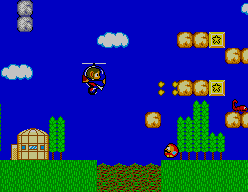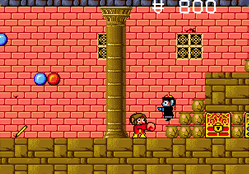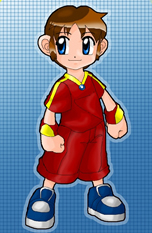Long before Sonic first laced up his sneakers and zoomed into the history books, Sega had another, more…unofficial mascot. With his big ears and even bigger selection of gadgets, Alex Kidd arrived on the Genesis near its launch. He already had four Master System adventures and an arcade game under his belt, and it seemed only natural that the little fellow make the transition to 16-bit alongside Joe Musashi and Harrier. To the general Sega fan at large, Alex Kidd seemed like he was going to be the spokesman for the Genesis, much the same way he had been for the Master System.
 Sadly, things would turn out much differently than anyone could imagine.
Sadly, things would turn out much differently than anyone could imagine.
Not only would Alex Kidd in the Enchanted Castle be the hero’s only appearance on the Genesis, it would be his final curtain call on new Sega hardware (Alex Kidd in Shinobi World was actually his last game ever, as it was released shortly after Enchanted Castle). Never again would he star in his own title, forced instead to make minor cameos in other games and as novelty merchandise. The ride was over, and as Sega moved in a new hardware direction, so did it change it’s advertising strategy, choosing to adopt a more mature and hip attitude, which was something Alex Kidd simply could not compete with.
Now, you’re probably thinking wasn’t Alex Kidd a Master System franchise? What does he have to do with the Genesis? The answer is simple, my friends. Although he had a notable presence on Sega’s 8-bit console, Alex’s last stand was on the Genesis, and it was that console’s newest hero, Sonic The Hedgehog, who did him in.
So Far the Fallen
It seems strange, doesn’t it? After a few different outings on the Master System, Kidd came back full circle with Enchanted Castle. All of his famous gadgets were back, as were the Jankenpo boss battles, and perhaps the only thing the game lacked was Miracle World‘s notorious challenge. The visuals had been ramped up considerably, and everything pointed to a fresh new start on a new platform. Why then, would Sega chose to not only replace Kidd, but to eliminate him entirely? Three platforms and a new direction later, and there’s still no sign of Alex Kidd making a comeback any time soon. He was even snubbed in the Sega Classics Collection!
To determine what ended his career so abruptly, one must go back to shortly after the debut of Sonic The Hedgehog. As the shining new face of Sega, the small mammal was tearing up the video game industry, on a mission to take supremacy from Nintendo and its darling Mario. Fast, brash, and full of attitude, Sonic represented everything Mario was not, giving Sega immediate distinction from its rival. The company now had an identity of its own, an appeal that attracted the older gamers who had grown up with the NES but were now looking for something different.
Where did this leave poor Alex? Considering just how similar he was to Mario, with his use of items and plodding pace, it wasn’t too much of a surprise to see him lose his place of stature. What it doesn’t explain is why he was never heard of again. Did Sega deliberately give him a pink slip? Was he consciously rejected by his creator?
Probably not. In fact, it’s most likely that Sega never had any malicious plans for Alex Kidd at all. The theory that he was replaced as mascot by Sonic holds little water, since Alex was never officially given the job. Even as a brand that Sega revisited more than others during the 8-bit era, the official link in the U.S. between the two was never really established. Sega of America made no attempt to promote him as their mascot, and in fact gave him more or less the same publicity they gave most of their other original properties. Games like Fantasy Zone and OutRun each received several installments on the Master System, and a few other titles were given the main stage only to be forgotten later on (anyone remember Quartet?). The mere fact that Alex had six separate adventures doesn’t necessarily mean that he was the official face of the company; it only means that he was a successful property. Of course, unofficially, Sega gamers saw the young hero as the representative of their favorite publisher.
That’s why it was only natural for him to make the jump to the Genesis. Shinobi, Space Harrier, Phantasy Star, and Thunderblade were there to launch the new platform, so why not Alex Kidd? There he was, greeting gamers on store shelves in an attempt to bring them into the fold. Sega had only achieved minimal market penetration with the Master System, but it felt the need to offer a smooth transition to those loyal gamers that had supported it in the past, so the Power Base Converter and several offers for free Master System games accompanied Sega’s most famous 8-bit franchises onto the Genesis. This was a collective effort, with no particular series standing out more than others in initial advertising, Alex Kidd included. In my mind, there had never been any interest to make Alex Sega’s mascot, and his fall from grace is most likely nothing more than a classic example of being in the wrong place at the wrong time.
Blind-Sided by Fate (or: Was that a Hedgehog?)
Sonic The Hedgehog was designed specifically to go head-to-head with Super Mario Bros. That was its purpose, and the developers never had a doubt during its creation of what role their new product would play in the future of Sega. He was to be the official mascot of an upstart publisher that was going to take on the industry leader and show gamers that a whole other world was out there for them to enjoy. He took upon his back the fate of an entire company, which under new president Tom Kalinske completely changed its strategies and tactics, resulting in an incredible boost in sales.
At this time, the Alex Kidd franchise had only received one entry on the Genesis, but Sega may have been plotting to bring it back for another run. Sonic might have changed all of this, as all efforts were channeled into making and establishing the new property. Think about it. How many other new platformers did Sega hype around the time of Sonic’s debut? How many actually stuck around? Still waiting for that Kid Chameleon sequel, aren’t we?
 It wasn’t really until later, when its star hedgehog had set the world on fire in America did the U.S. branch of Sega actually begin searching for new characters and franchises, few of which did anything of merit. The Sega Technical Institute, founded and run by Marble Madness creator Mark Cerny, was almost exclusively charged with this assignment, and they came up with several new characters like Greendog, the Ooze, and Comix Zone. None however, could match Sonic’s success (an observation that still holds true to this day) and sequels never materialized for any of them. The Blue Blur has been seemingly invincible for fifteen years, despite serious dips in game quality. Still, it seems that anything even remotely related to the brand is successful, which explains why the horrible Shadow the Hedgehog sold over a million units worldwide.
It wasn’t really until later, when its star hedgehog had set the world on fire in America did the U.S. branch of Sega actually begin searching for new characters and franchises, few of which did anything of merit. The Sega Technical Institute, founded and run by Marble Madness creator Mark Cerny, was almost exclusively charged with this assignment, and they came up with several new characters like Greendog, the Ooze, and Comix Zone. None however, could match Sonic’s success (an observation that still holds true to this day) and sequels never materialized for any of them. The Blue Blur has been seemingly invincible for fifteen years, despite serious dips in game quality. Still, it seems that anything even remotely related to the brand is successful, which explains why the horrible Shadow the Hedgehog sold over a million units worldwide.
No, what killed Alex Kidd is the same thing that ended the lives of the aforementioned franchises: a change in market tastes. Like Greendog and Kid Chameleon, Alex Kidd featured slow paced gameplay that promoted exploration and item collection, as opposed to blasting through areas via loops and chutes. There was nothing speedy about any of it. As Sonic The Hedgehog became more and more popular, gamers gravitated towards the blazing speed and levels designed to take advantage of it all (blast processing!). The others characters of the era were left in his wake, with the exception of a notable few like ToeJam & Earl, and were no longer considered part of the corporate scheme. Alex Kidd, with his silly look, happy outlook, and rock-scissors-paper battles, was essentially Laser Disc to Sonic‘s DVD. He never stood a chance.
Another nail in the Kidd’s coffin was gaming’s transition to 3D, which not only saw the end of several successful franchises, but their developers as well. Few 16-bit platformers were able to make the jump and the few that did, such as Bubsy, were perhaps better left in only two dimensions. It was a dark time for many franchises, and as publishers scrambled to embrace the new technology, everything 2D became passé. Sega’s immense difficulties during this period with both the 32X and the Saturn made the thought of bringing Alex back almost inconceivable. So lost was the company that it even fumbled the ball with its star brand, and Sonic never got the true platform adventure that fans were clamoring for. Instead, Sega tried to forge ahead once more with new franchises, leaving its back catalogue behind almost entirely. Even those few games that were updated suffered changes in order to reflect modern tastes. Golden Axe, for example, was revived as a fighting game, despite having a proper hack-‘n-slash arcade sequel in Revenge of Death Adder.
No, Alex’s chances of a return were slim, and the window was steadily closing.
About Time for a Comeback?
 While we can’t blame Sega for allowing Sonic to steal Alex’s thunder, as it was the most sound decision to make at the time, there’s no excuse today for letting such a promising and enjoyable franchise continue to rot. With the great strides made in 3D on the current consoles, the time may just be ripe for Alex Kidd to make a comeback. Imagine a massive world, like those of Ratchet & Clank or Sly Cooper, for Alex to run around in. Think of what it would be like to cruise through huge and detailed environments in his pedi-copter, or race around on his motor cycle. Franchises like Alex Kidd and Kid Chameleon literally scream for new entries in full 3D, and Sega could possibly revitalize these long-dormant series by bringing them into the next generation. If Golden Axe and Altered Beast can get a shot, then why not the Kidd?
While we can’t blame Sega for allowing Sonic to steal Alex’s thunder, as it was the most sound decision to make at the time, there’s no excuse today for letting such a promising and enjoyable franchise continue to rot. With the great strides made in 3D on the current consoles, the time may just be ripe for Alex Kidd to make a comeback. Imagine a massive world, like those of Ratchet & Clank or Sly Cooper, for Alex to run around in. Think of what it would be like to cruise through huge and detailed environments in his pedi-copter, or race around on his motor cycle. Franchises like Alex Kidd and Kid Chameleon literally scream for new entries in full 3D, and Sega could possibly revitalize these long-dormant series by bringing them into the next generation. If Golden Axe and Altered Beast can get a shot, then why not the Kidd?
I would certainly love to see this brand given another chance, and since Sega seems to be on a nostalgia kick, the time may just be right for it. Deviant artist extraordinaire Sarumaru came up with this excellent interpretation of what Alex Kidd might look like if he returned today. Hey, you never know!
- Alex Kidd 2005 art property of Sarumaru.

Recent Comments